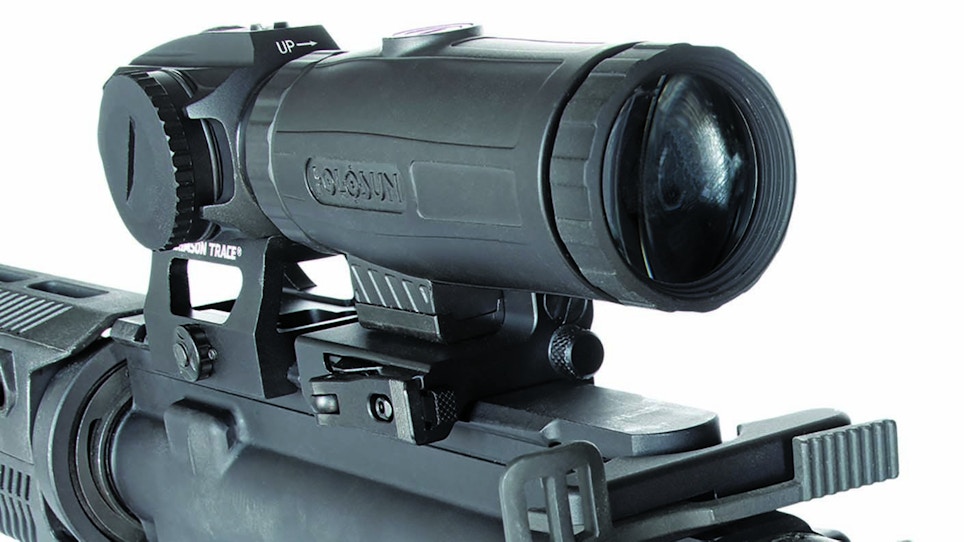Magnifiers are the Rodney Dangerfields in the optical world — they “don’t get no respect.” They’re used, abused and taken for granted and, despite it all, they continue to perform with cutting-edge versatility through challenging conditions.
Riflescopes dominate headlines, but a magnifier’s mission rarely gets the same attention. They must also be tough enough to handle recoil, minimize light rejection on glass surfaces and battle the elements with a water-resistant housing and gas purging. Add the need for speed and security when locking into or out of the field of view and it could be their job is slightly tougher. Precise at 1,000 meters isn’t the mission, but stretching that CQB dot’s effectiveness out to 100 or slightly beyond, quickly and efficiently, is.
Odds are good you have a few in stock and have an intimate familiarity with their virtues. Chances are more than a few of your customers will pick up a red dot in the next few months for their AR, and an offer to mount a magnifier is a good way to bolster the bottom line and build loyalty.
It’s also an opportunity to reinforce some of the disadvantages of Internet purchases. Not all magnifiers mount at the same height or mate with every red-dot sight. Yes, some come with height adapters to ensure proper alignment and a lot of companies have compatibility charts, but rail space and eye relief also come into play. Explaining those facts, along with the advantages of the unit you recommend, heightens their awareness and emphasizes your store’s expertise.
Installation is simple and will likely take less than 10 minutes. Start, as always, by pointing the gun in a safe direction. Drop the magazine and place it away from your work area. Rack the bolt carrier group back, lock and inspect to ensure there is no cartridge in the chamber.
Assess the position of any red-dot sight already installed on the Picatinny and discuss eye relief preference with the owner. It will need to move forward if it’s all the way back toward the buttstock, otherwise there is no room to anchor the magnifier. Pushing that aiming point further forward can feel unfamiliar to some enthusiasts.
Open the magnifier box, consult the instructions if needed and inventory parts. Ensure the optic is nick-free and the finish is to your satisfaction. Things happen in shipping departments.
Remove the red-dot, if needed, and clean the Picatinny rail area where both optics will mount. Grime in those grooves works loose over time and often results in a dissatisfied customer. A few seconds here saves a lot of heartache later, and there’s a subliminal message delivered.
Clean the magnifier’s base of any debris along with that of the removed red-dot sight. Then mount both securely, starting with the magnifier as close to the shooter as shooter and the sight in front and adjacent. Apply forward pressure with your fingers on both units as the nuts or levers on the bases lock firmly into place. Allowing them to float freely as things tighten increases the chances of working loose under recoil.
Rotate the magnifier in and out of the field of view several times to ensure the mechanism works freely and locks out securely when not in use. Odds are good it will, but lubricate according to manufacturer recommendations if not, or tighten if needed.
Now remind the owner to keep the gun pointed in a safe direction and hand the AR to them. Activate the red-dot and ask them to check eye relief with the magnifier in line and to the side. Alter the optics’ positions on the rail if necessary.
This is also a good time for the customer to adjust the diopter so the field of view through the magnifier is crystal clear. Have them swing the gun up from the low-ready position without the magnifier engaged to determine comfort level and familiarity (particularly if you’ve moved the red-dot).
The final step is to adjust the dot position in the magnifier. Odds are good it’s not yet centered, but quality magnifiers have so-called windage and elevation adjustments.
With the dot on and using the appropriate tool — or better yet the one provided with the magnifier — sight through both optics and slowly turn the magnifier dials until the aiming point centers. Now you’re ready to hand the AR back to the customer to double check the setting.
Before you let that happy customer go out the door, don’t forget to ask whether they’ve changed that red-dot battery recently and suggest ammo for their next range session.






